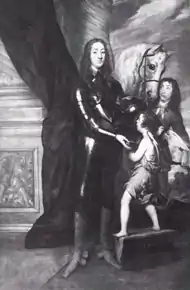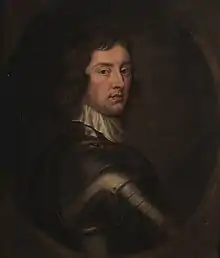Drayton House
Drayton House is a Grade I listed[1] country house of many periods[2] 1 mile (1.6 km) south-west of the village of Lowick, Northamptonshire, England.
| Drayton House | |||||||||||||||||||||||||||||||||||||||||||||||||||||||||
|---|---|---|---|---|---|---|---|---|---|---|---|---|---|---|---|---|---|---|---|---|---|---|---|---|---|---|---|---|---|---|---|---|---|---|---|---|---|---|---|---|---|---|---|---|---|---|---|---|---|---|---|---|---|---|---|---|---|
 Drayton House from the South-East
| |||||||||||||||||||||||||||||||||||||||||||||||||||||||||
| |||||||||||||||||||||||||||||||||||||||||||||||||||||||||
.svg.png.webp) Location of Drayton House in Northamptonshire | |||||||||||||||||||||||||||||||||||||||||||||||||||||||||
Described as Northamptonshire's most impressive medieval mansion by Nikolaus Pevsner,[3] "one of the best-kept secrets of the English country house world" by architectural historian Gervase Jackson-Stops,[4] and (affectionately) "a most venerable heap of ugliness, with many curious bits" by Horace Walpole,[5] the house is generally held to have been begun in 1328,[6] and there have been changes to the house in each century since, including works recorded by Isaac Rowe, John Webb, William Talman, Gerard Lanscroon, William Rhodes, Alexander Roos, George Devey and John Alfred Gotch. It sits in a park of about 200 acres known as Drayton Park.[7]
It has passed only by inheritance since it was last sold in 1361,[8] although this was itself an arrangement within extended family[9] who had been there for nearly 300 years already.[10] It is currently owned by the Stopford Sackville family[11][12] and is open by prior written appointment.[13][14]
History

The de Veres, later de Draytons
Aubrey de Vere I participated in the Norman conquest of England and, after the Geoffrey de Montbray, Bishop of Coutances forfeited it,[7] he may have been awarded the manor of Drayton near Northampton,[9] or it may have been awarded to his son, Aubrey de Vere II.[7] Aubrey II was made Great Chamberlain by Henry I in 1133,[9] and died in a riot in London in 1141.[9] Whilst Aubrey III, his eldest son, eventually rose to become Earl of Oxford in 1156,[9] Drayton passed to his younger son, Robert.[7]
Robert married twice, second to Maud de Furnell, mother of Henry, to whom Drayton passed on his death.[7] In the early thirteenth century, after inheriting Drayton from after his father's death in 1193-4, his son, Sir Walter de Vere, perhaps dropped the "de Vere" family name, and assumed the surname "Drayton", taken from the village,[9][6][15] although this may also have been Walter's son, Henry.[7] On Sir Walter's death in 1210-11, the house passed to Henry, later Sir Henry, and upon Sir Henry's death in 1253, to Sir Henry's thirty-year-old[7] son, Baldwin, who died in 1278. Baldwin passed the estate to his son John, who is held by some sources to have built the present "crypt"[9] and died in 1291.[7]
Although still a minor 8 years after his father's death in 1299, Sir Simon de Drayton would go on to success, being member of parliament for Northamptonshire several times between 1320 and 1347,[7][6] and likely began construction of the house present today in 1328, when he received a licence to crenellate.[9][16] On his widow's death in 1359, it passed briefly to his son, John, before John quickly passed it to his son, Baldwin.[7] However, it was soon purchased by Sir Henry Green in 1361[8][17] or 1362.[7] This purchase was a somewhat obscure arrangement[9] in which Sir Henry's second son, also Henry, would have the estate instead of John's son, who was Sir Henry's nephew through his wife, Katherine.[7]
The Greens
The first Sir Henry Green, of Boughton,[Note 1] was Chief Justice between 1361 and 1365. On his death in 1370,[7] Drayton passed to his younger son, who was described in a later family genealogy as "the delight and hopes of his old father".[7] The second Henry was a favourite of Richard II, consequently being executed in 1399 for his support for Richard by Henry Bolingbroke, later King of England.[6]
Nonetheless, soon after his father's beheading, Ralph Green was returned to his father's estates, including Drayton. It eventually passed to Ralph's nephew, another Henry Green, who was High Sheriff through the Wars of the Roses, reportedly acting impartially and thus saving his landholdings — at that time "one of the most considerable Estates ... in the posession of any Gentlemen in the Kingdom of England".[9] Upon his death in 1467, he passed the house, via his only child Constance, to John Stafford, a son of the Duke of Buckingham.
The Staffords

John Stafford would become Earl of Wiltshire in 1470, a reward for fighting for the Yorkist cause. For these allegiances, he would be prevented from attending parliament later that year, as Henry VI, from the House of Lancaster, had returned to the throne. Despite his father's loyalties, John's son Edward is often called a Lancastrian, by consequence of his support for Henry VII, fighting for him at the Battle of Blackheath and entertaining him at the house in 1498.[9][6] Returning ill from Blackheath, Edward was without heirs, and it would seem he was initially keen for his wife, Margaret, daughter of the Lord Lisle, to have Drayton for life. However, Margaret was not happy with this will, wanting the manor of Warminster. It would seem that Edward thenceforth wished the Earl of Shrewsbury, a cousin, to have Drayton, not wanting his other cousins, women and descendents of the original Sir Walter de Drayton, to inherit.[9]
However, Sir John Mordaunt (d. 1506), the serjeant-at-law present at Wiltshire's death, had obtained the wardship of the female cousins, and wished for the eldest, Elizabeth, to marry his son, John (d. 1562). Thus, John (d. 1506) seems to have ensured that Wiltshire's will was in his son's favour.[9] Nonetheless, from Edward's death in 1499, there was a 16-year-long period during which the heir to the house was disputed,[18] before being resolved to in John Mordaunt's (d. 1562) favour.
The Mordaunts
.jpg.webp)
The Mordaunts were originally from Turvey, Bedfordshire.[19] Upon Elizabeth Mordaunt (née Vere) inheriting in 1515, John Mordaunt (d. 1506) had already died, and his son John (d. 1562) already had an heir, himself also called John. It has been suggested that Henry VIII was involved in ending the dispute favourably for John (d. 1562), given their amicable early relationship.[9] Indeed, John (d.1562) rose to the Privy Council, was created Lord Mordaunt in 1532,[6] and had managed to cheaply purchase the marriage of Ella Fitzlewis, who had a large fortune, from the King for his son. However, this good relationship was not to last, as he grew increasingly unhappy with the dissolution of the monasteries, and so withdrew from court life to the house. His enemies reportedly encouraged King Henry to force him into an agreement much akin to, and similarly as unfavourable as, the deal into which Thomas Cranmer had been forced over Knole. However, Henry died before they could realise their goal, and John lived through the turbulent times of Mary I and Edward VI, dying in 1562, in the reign of Elizabeth I.[9]
His son, John (d. 1571), therefore inherited the house and the title, becoming 2nd Baron Mordaunt. However, he only enjoyed the house for 9 years, before passing it to his son, Lewis (1538-1601). Lewis, whilst not a member of the court, lived in opulence and greatly altered and enlarged Drayton.[6][9]
He lived indeed in much magnificence and in a port that was a pattern for the Great Men of that time, so as his Hospitality is to this day famous.
— Halstead, Succinct Genealogies (1685)
The disparity between his lifestyle and situation required Lewis to sell both the FitzLewis estates of his mother and the Latimer estates of his great-grandmother.[9] Lewis was also one of the judges present at the trial of Mary, Queen of Scots at Fotheringhay, although sympathetic to Catholicism.[9]
Lewis had a son, Henry (1568-1610),[6] who inherited the house on his death in 1601. From the 3rd of August 1605, Henry entertained James VI and I and Anne of Denmark at Drayton for three days with musicians and singers.[9][20] According to the queen's secretary, William Fowler, the guests included the Earls of Worcester, Devonshire, Northampshire [sic], Sussex, and Salisbury, and the Duke of Lennox.[21] Nevertheless, Henry (1568-1610) concealed priests at Drayton — the house retains one priest hole[22] — and was heavily suspected of involvement in the Gunpowder Plot of later that very same year.[6] Indeed, Robert Keyes – sometimes quoted as the keeper of his Turvey house,[9] and other times as the husband of the governess of Henry's children[23] – was a key conspirator and hid at Drayton after the plot's demise.[24] For his involvement, Henry (1568-1610) was fined £666 13s 4d[6] and imprisoned in the Tower, with some sources even reporting that he died there in 1608.[9][22] Either way, he died before his successor and son, John (1599-1643), was of maturity.
John was taken from Catholic relations and raised by George Abbot, Archbishop of Canterbury, from 1611. Well regarded, he was called "the Star of the University" whilst at Oxford, and thus he caught James I's eye, so meaning he was relieved from the remaining £10,000 fine placed on his father.[9] However, soon the King met George Villiers, and all chance at being royal favourite was lost. Nevertheless, he remained on good terms with Charles, then Prince of Wales, playing a key role in his investiture as Prince of Wales. Therefore, he secured a good marriage to Elizabeth, daughter of Lord Howard of Effingham, and was created Earl of Peterborough in 1628. Initially, along with his two sons, he was a Royalist in the Civil War. In a turn of events, however, his wife, a "great Republican", persuaded him to be a Roundhead[25] and he became a General of Ordnance in the Parliamentary army.[6]
John's son and successor, Henry (1623-1697), was only 17 when he inherited. This situation was exploited by his mother, who ensured that much of John's estate was left to her as jointure, in a settlement drawn up on his deathbed. This left Henry with "but a very small Estate to live upon when he became Earle [sic]," believing he had inherited only the Turvey estate. However, John had actually executed a deed beforehand which meant that Henry inherited all his estate, but this deed was concealed from Henry by his mother. It was not until 1669, when the original deed was found, that Henry was able to discover this and so take his mother to court, regaining ownership of his estates.[26] and he became a General of Ordnance in the Parliamentary army.[6]
Henry quickly returned to being a Royalist in the Civil War,[25] and he became a General of Ordnance in the Parliamentary army.[6] and did not quickly give up this cause. Initially exhausting his wife's dowry in fines, he was later forced to compound for his estates[9][6] in 1646.[27] and he became a General of Ordnance in the Parliamentary army.[6] Regardless, he was involved in the Second English Civil War with the Earl of Holland, of whom a full-length portrait by Mytens still hangs in the Dining Room.[9][28][29] However, after being compounded a second time in 1649, he retreated to Drayton, his mother — despite her sympathetic allegiances — retiring to Reigate after harassment in 1650 by Parliamentarians, allowing him to negotiate to take on the lease.[30] and he became a General of Ordnance in the Parliamentary army.[6]
This was not the case for his brother, John (1627-1675), who continued in his convictions and was saved by a single vote from execution for his role in the 1658 conspiracy.[31] This resulted in John's (1627-1675) elevation to the peerage as Viscount Mordaunt of Avalon and Baron Mordaunt of Reigate in 1659. Despite Henry's (1623-1697) position as elder son, on his mother's death in 1671, he did not gain her Reigate estates as he had expected to, the estate passing instead to his brother (whose peerage was "of Reigate").[31] In addition, John seems to have been involved in their mother's concealing of their father's deeds from Henry.[25] This resulted in litigation between the two brothers, which Henry (1623-1697) lost, and so he was left a thousand pounds per year less well off.[31] Therefore, to increase funds, Henry (1623-1697) accepted the position of Governor of Tangier from 1661 to 1663, although he resigned it swiftly for a pension which was worth that thousand pounds per year.[31] He was later Ambassador to France, First Gentleman of the Bedchamber, and Groom of the Stole to the Duke of York.[6] He was also chosen to arrange the marriage of Mary of Modena with the Duke of York. During this time, he also worked with his chaplain, “Mr Rans”, to produce a family history, Succinct Genealogies, published in 1685, under the pseudonym "Halstead".[9] Other sources hold that a "Robert Halstead" was indeed his chaplain at this time, rather than it being a pseudonym.[32] and he became a General of Ordnance in the Parliamentary army.[6]

By this time, his nephew Charles had succeeded John (1627-1675) as Viscount Mordaunt. A Whig, Charles was suspected in the Rye House Plot, moving to Holland, reportedly being the first person to encourage William of Orange "to undertake the business of England."[31] Through the success of the Glorious Revolution, he returned to England and was created Earl of Monmouth. Meanwhile, Henry (1623-1697) had become a suspect in the Popish Plot, and openly admitted to his religious conversion to Catholicism in 1687. This led to his impeachment and imprisonment for this recusancy in 1688, from which he was released in 1690.[31]
After Henry's death in 1697, the Peterborough Earldom and older Mordaunt Barony split due to different remainders. Henry had ensured that the Drayton would pass with the barony to Mary Howard (née Mordaunt), Duchess of Norfolk, instead of with the earldom earldom to his nephew, Charles.[6] It would seem this was more out of spite for the Reigate side of the family, the split between the two never having been resolved, than for his daughter's merits. Charles would dispute this descent for the next twenty years.[31]
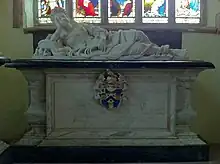
Mary had been married to Henry, Earl of Arundel in 1677. Within seven years, he had succeeded as Duke of Norfolk.[31] However, the marriage was not to last, and the Duke spent over half of his time in the marriage attempting to divorce Mary. It would seem that Mary quickly took a fancy to Sir John Germain, 1st Baronet (1650-1718), described as "always a distinguished Favourite of the other Sex."[31] From soon after, in 1685,[33] she no longer apparently lived with the Duke, and her relationship with Sir John was well-known.[31] Finally, in April 1700, after the Duke, who openly had a mistress himself,[34] had already tried twice, a divorce was allowed[31] by Parliament.[34] Mary married her lover after the Duke's death in 1701.[35] Nevertheless, she continued to use both the arms and style of "Duchess of Norfolk".[8] On her death in 1705, the house passed to her new husband,[6] not without dispute by her cousin Charles,[36] who unsuccessfully tried to gain the house in the courts in both 1705 and 1710. Thus, there was hostility between Sir John and the Earl, which may have made its way into later descriptons of Sir John.[31]
The Germains
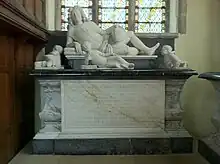
Sir John was a soldier and prominent member of the court of William III. His mother was herself "very handsome" and was supposedly the wife of a private soldier in William II, Prince of Orange's Life Guards.[31] However, she was rumoured to be a mistress of William II, so making Sir John the illegitimate half-brother of William III.[8][6] Some saw William III's positive attitude[33] towards Sir John as further evidence of this, especially when considering his personality; Horace Walpole, a frequent visitor throughout the 1760s,[5] described Sir John as having "defective morals,"[31] and yet the King twice influenced the House of Lords to not allow a divorce between the Duke and Duchess of Norfolk, and then gave John a baronetcy in 1698.[31] Others stressed that he was a skilled soldier anyway, accompanying William III during the 1688 Glorious Revolution and later conflicts. Despite such skill, no records remain of the feats he may have performed.[31]
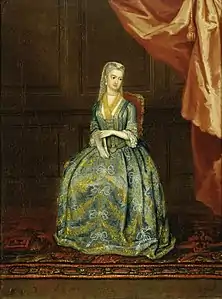
On his death in 1718, he passed the house on to his much younger second wife, who he married in 1706,[31] Lady Elizabeth (Betty) Germain (née Berkeley) (1680-1769).
Betty and Sir John had had three children, but all died in infancy. Thus, on his death bed, Sir John reportedly encouraged her to remarry — this time not to an old man — and secure an heir for the estate, and if this was not possible, to pass it on to a younger son of his "Friend, the Duchess of Dorset."[31] Betty maintained the house as Sir John had left it[37] and did not remarry. She was often at Knole, the Kent country house of the Dukes of Dorset, and the Dorsets similarly visited her frequently, too,[31] with her spending every summer after her husband's death at Drayton.[36] Indeed, Lord George Sackville (1716-1785) went straight to Drayton after his wedding to visit Betty, a close friend.[31] Therefore, true to Sir John's wishes, she gave the house to George, her cousin[6] and a son of the Duchess of Dorset, on her death.[31]
The Sackvilles
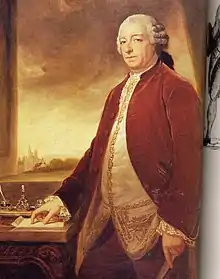
Thus the house passed to the Sackville family, although George changed his name to Germain upon inheriting. With George already established at Stoneland Lodge, Drayton was now only occasionally in residential use.[31] However, this did not stop him from undertaking refurbishments to catch up with the 50-year backlog, although these were curtailed by his becoming Secretary of State for the Colonies and so no longer being able to reside at Drayton for long periods, being needed in London.[6] He was made Viscount Sackville in 1782.[31] Upon his death in 1785, his son, Charles, was still a minor.
Charles would go on to inherit the Dorset Dukedom in 1815, when his cousin was killed in Ireland. However, he had a keen interest in horse racing and was not often at Drayton, at times even letting it to his brother, George.[31] It was through his brother's line that Drayton would descend on his death (which resulted in the extinction of the Dukedom and Viscountcy) in 1843, passing to George's daughter, Caroline Harriet Sackville,[38][39] and her husband, William Bruce Stopford,[29][40] from 1870[39] Stopford-Sackville.[38] It has continued to pass through her descendents since,[31] passing to their son, Sackville "Sack"[39] George[7] Stopford-Sackville, member of parliament for North Northamptonshire 1867-80, and then again 1900-1906. When he died without issue[39] in 1926, his brother had been dead for twenty years already,[41] and his two eldest nephews had both died in the war.[42] Therefore, the house passed to his youngest[43] nephew, Nigel Victor Stopford-Sackville,[7][41] who would go on to be an officer in the army[44] and write a "short historical account of ownership, architecture, and contents" of the house.[45][46] Nigel's son, Lionel Geoffrey[47] Stopford Sackville, inherited the house on his father's death in 1972[44] and moved to live at Drayton in 1973, commencing a series of restorations over the next two decades.[48] It is now owned by his son, Charles Lionel[49] Stopford Sackville.[50]
During the late 19th century the Park was the host location for an early Victorian era tennis tournament called North Northamptonshire LTC Tournament[51] organised by North Northamptonshire Lawn Tennis Club that was held between 1880 and 1883.
House and interior
Although most likely begun by Sir Simon de Drayton upon gaining a licence to crenellate in 1328,[6] some have also claimed that the cellar to the original solar of the house predates this[9] and is from the reign of Edward I. If this were true, then it would have been built be Sir Simon's father, Sir John. Regardless, by the time of Sir Simon there was almost certainly a house, similar in original layout to Penshurst, with a defensive wall and moat around it.[9] However, the house underwent transformation during the late 17th and early 18th centuries, much in the rare English Baroque. There is a unique spiral cantilever oak staircase dating from around 1680 and an embroidered State Bed from 1700. It is built of squared coursed limestone and limestone ashlar with lead and Collyweston stone slate roofs.
By the time of a 1540 visit by John Leland, he believed most of the house he saw to have been built by Henry Green (d. 1399). However, more modern authors have attributed the house's enlargement to this Henry's great-nephew, another Henry Green.[9] Many of the later medieval alterations are believed to have been at the behest of the 2nd Earl of Wiltshire.[6]

After passing to the Sackville family, two rooms were redecorated in the Adam style.[13] Pevsner considered these to be the best examples of the style in Northamptonshire.[52]
Park and gardens
A park has existed at Drayton since at least when Sir Simon de Drayton received a licence to empark 30 acres in 1327. The park, known as Drayton Park, now stretches to about 200 acres,[7] and has been described as "vast".[53]
Principal owners of the house
- Sir Simon de Drayton 1300 – 1357
- John de Drayton 1358
- Baldwin de Drayton 1358 – 1362
- Sir Henry Green 1362 – 1370 Chief Justice of the King's Bench
- Sir Henry Green 1370 – 1399
- Ralph Green 1400 – 1417
- John Green 1417 – 1433
- Henry Green 1433 – 1467
- John Stafford, 1st Earl of Wiltshire 1467 – 1473
- Edward Stafford, 2nd Earl of Wiltshire 1473 – 1498
- John Mordaunt, 1st Baron Mordaunt 1515 – 1561
- John Mordaunt, 2nd Baron Mordaunt 1561 – 1571
- Lewis Mordaunt, 3rd Baron Mordaunt 1571 – 1601
- Henry Mordaunt, 4th Baron Mordaunt 1601 – 1610
- John Mordaunt, 1st Earl of Peterborough 1610 – 1642
- Henry Mordaunt, 2nd Earl of Peterborough 1642 – 1697
- Mary Howard, 7th Baroness Mordaunt, and Sir John Germain, 1st Baronet 1697 – 1718
- Elizabeth Germain 1718 – 1769
- George Germain, 1st Viscount Sackville 1770 – 1785
- Charles Sackville-Germain, 5th Duke of Dorset 1785 – 1843
- William Bruce Stopford[54] 1843 – 1872
- Sackville Stopford-Sackville 1872 – 1926
- Nigel Victor Stopford Sackville 1926 – 1972
- Lionel Geoffrey Stopford Sackville 1972 – 1997
- Charles Lionel Stopford Sackville 1997 – present
Main rooms
- Late-thirteenth-century solar undercroft.
- Medieval Great Hall remodelled early in the eighteenth century by William Talman and decorated by Alexander Roos c.1850 to simulate marble.
- Dining room (originally the medieval buttery and pantry). Remodelled c.1771/74 by William Rhodes possibly to design by William Chambers.
- The Green Drawing Room, remodelled c.1773 by W. Rhodes
- The Blue Drawing Room, with decoration by John Webb
- The State Bedroom remodelled c.1653 by John Webb. This room has a priest hole above it.
- Lacquer closet off State Bedroom with panels of Chinese Coromandel screens
- The chapel
- The King's Dining Room (originally the medieval solar)
- The library (originally the long gallery)
In popular culture
The house and gardens were used as “Saltburn” in Emerald Fennell's eponymous 2023 motion picture, Saltburn.[55]
See also
- Noble Households – book with Drayton House inventories of 1710 and 1724
Notes
- This is the Boughton, Northamptonshire which had Boughton Hall, not Boughton House, which is near to Drayton but was a monastic building.
References
- Historic England. "Drayton House (1040293)". National Heritage List for England. Retrieved 17 September 2023.
- "Visit to Easton Neston and Drayton House" (PDF). Columns (Mailing list). Summer 2001. Retrieved 15 October 2023.
- Pevsner, Nikolaus; Cherry, Bridget (2002) [1973]. Northamptonshire (Pevsner Architectural Guides: Buildings of England). New Haven, USA and London: Yale University Press. p. 46. ISBN 978-0300096323.
- Jackson-Stops, Gervase (January 1991). "Drayton House Revisited". Architectural Digest. London: Condé Nast. p. 60.
- Jackson-Stops, Gervase (January 1991). "Drayton House Revisited". Architectural Digest. London: Condé Nast. p. 61.
- Heward, John; Taylor, Robert (1996). The Country Houses of Northamptonshire. Swindon: Royal Commission on Historical Monuments. pp. 175–189. ISBN 978-1873592212.
- Page, William, ed. (1930). "Parishes: Lowick". A History of the County of Northampton: Volume 3. Victoria County History. pp. 231–243. Retrieved 31 August 2020.
- Jackson-Stops, Gervase (January 1991). "Drayton House Revisited". Architectural Digest. London: Condé Nast. p. 64.
- "Drayton House. — I Northamptonshire". Country Life. 31 (806): 898–908. 15 June 1912. Archived from the original on 16 November 2021.
- "Lowick, Northamptonshire". Country Life. 5 November 2004. Retrieved 15 October 2023.
- Jackson-Stops, Gervase (January 1991). "Drayton House Revisited". Architectural Digest. London: Condé Nast. p. 58.
- "FALL STUDY TRIP ABROAD 2014". Retrieved 15 October 2023.
- "Drayton". Northamptonshire Surprise. Retrieved 15 October 2023.
- Foster, Janet; Sheppard, Julia (2002). British Archives: A Guide to Archive Resources in the UK: Fourth Edition. Basingstoke: Palgrave. pp. 270–271. ISBN 978-1-349-65230-3.
- Magnolia Plantation and Gardens By Derek Fell. Giibs Smith. 2009
- Pevsner, Nikolaus; Cherry, Bridget (2002) [1973]. Northamptonshire (Pevsner Architectural Guides: Buildings of England). New Haven, USA and London: Yale University Press. p. 189. ISBN 978-0300096323.
- Pevsner, Nikolaus; Cherry, Bridget (2002) [1973]. Northamptonshire (Pevsner Architectural Guides: Buildings of England). New Haven, USA and London: Yale University Press. p. 190. ISBN 978-0300096323.
- Emery, Anthony (2000). Greater Medieval Houses of England and Wales, 1300–1500: Volume 2, East Anglia, Central England and Wales. Cambridge, UK: Cambridge University Press. pp. 233–237. ISBN 978-0521581318.
- Bailey, Bruce (2004). "John Webb at Drayton House" (PDF). The Georgian Group Journal. 14: 187. Retrieved 15 October 2023.
- Andrew Ashbee, Records of English Court Music, 1603–1625, vol. 4 (1991), p. 197: John Nichols, Progresses of James the First, vol. 1 (London, 1828), p. 523.
- HMC Lord De L'Isle & Dudley, vol. 3 (London, 1936), p. 188.
- Pevsner, Nikolaus; Cherry, Bridget (2002) [1973]. Northamptonshire (Pevsner Architectural Guides: Buildings of England). New Haven, USA and London: Yale University Press. p. 191. ISBN 978-0300096323.
- Spray, Jo. "Were the Mordaunts involved in the Gunpowder Plot?". Turvey History. Retrieved 24 September 2023.
- Fraser, Antonia (2005) [1996], The Gunpowder Plot, London: Phoenix, ISBN 0-7538-1401-3
- Bailey, Bruce (2004). "John Webb at Drayton House" (PDF). The Georgian Group Journal. 14: 190. Retrieved 15 October 2023.
- Bailey, Bruce (2004). "John Webb at Drayton House" (PDF). The Georgian Group Journal. 14: 190–191. Retrieved 15 October 2023.
- Bailey, Bruce (2004). "John Webb at Drayton House" (PDF). The Georgian Group Journal. 14: 192. Retrieved 15 October 2023.
- Jackson-Stops, Gervase (1978). Drayton House. London: Curwen Press. p. 16.
- Jackson-Stops, Gervase (January 1991). "Drayton House Revisited". Architectural Digest. London: Condé Nast. p. 65.
- Bailey, Bruce (2004). "John Webb at Drayton House" (PDF). The Georgian Group Journal. 14: 191. Retrieved 15 October 2023.
- "Drayton House. — II Northamptonshire". Country Life. 31 (807): 934–944. 22 June 1912. Archived from the original on 16 November 2021.
- Bailey, Bruce (2004). "John Webb at Drayton House" (PDF). The Georgian Group Journal. 14: 196. Retrieved 15 October 2023.
- Bailey, Bruce (2020). "Towers and staircases: the transformation of Drayton House under the direction of William Talman 1702-1704" (PDF). The Georgian Group Journal. 28: 38. Retrieved 15 October 2023.
- Bailey, Bruce (2020). "Towers and staircases: the transformation of Drayton House under the direction of William Talman 1702-1704" (PDF). The Georgian Group Journal. 28: 39. Retrieved 15 October 2023.
- Pevsner, Nikolaus; Cherry, Bridget (2002) [1973]. Northamptonshire (Pevsner Architectural Guides: Buildings of England). New Haven, USA and London: Yale University Press. p. 192. ISBN 978-0300096323.
- Ponsonby, Margaret (2016) [2015]. Faded and Threadbare Historic Textiles and their Role in Houses Open to the Public. London: Routledge Publishing. p. 125. ISBN 978-1472424679.
- Ponsonby, Margaret (2016) [2015]. Faded and Threadbare Historic Textiles and their Role in Houses Open to the Public. London: Routledge Publishing. p. 124. ISBN 978-1472424679.
- Hesilrige, Arthur (1921). Debrett's peerage, and titles of courtesy, in which is included full information respecting the collateral branches of Peers, Privy Councillors, Lords of Session, etc. Debrett's Peerage. London: Dean & Son Ltd. p. 240. Archived from the original on 13 September 2016.
- Draper, Karey (2016). "A Tale of Two Brothers: The Stopford Sackvilles and the First World War". Northamptonshire Past and Present. 69: 53. Retrieved 16 October 2023.
- Hesilrige, Arthur (1921). Debrett's peerage, and titles of courtesy, in which is included full information respecting the collateral branches of Peers, Privy Councillors, Lords of Session, etc. Debrett's Peerage. London: Dean & Son Ltd. p. 195. Archived from the original on 13 September 2016.
- Hesilrige, Arthur (1921). Debrett's peerage, and titles of courtesy, in which is included full information respecting the collateral branches of Peers, Privy Councillors, Lords of Session, etc. Debrett's Peerage. London: Dean & Son Ltd. p. 241. Archived from the original on 13 September 2016.
- Draper, Karey (2016). "A Tale of Two Brothers: The Stopford Sackvilles and the First World War". Northamptonshire Past and Present. 69: 53–70. Retrieved 16 October 2023.
- Draper, Karey (2016). "A Tale of Two Brothers: The Stopford Sackvilles and the First World War". Northamptonshire Past and Present. 69: 55. Retrieved 16 October 2023.
- "Nigel Victor Stopford Sackville (1901-1972), Army officer". National Portrait Gallery. Retrieved 17 October 2023.
- "Drayton House Northamptonshire : a short historical account of ownership, architecture and contents /". National Trust Collections. Retrieved 17 October 2023.
- Bailey, Bruce (2004). "John Webb at Drayton House" (PDF). The Georgian Group Journal. 14: 198. Retrieved 15 October 2023.
- "Lionel Geoffrey STOPFORD SACKVILLE". Companies House. Retrieved 16 October 2023.
- Jackson-Stops, Gervase (January 1991). "Drayton House Revisited". Architectural Digest. London: Condé Nast. pp. 65–67.
- "Charles Lionel STOPFORD SACKVILLE". Companies House. Retrieved 16 October 2023.
- Draper, Karey (2016). "A Tale of Two Brothers: The Stopford Sackvilles and the First World War". Northamptonshire Past and Present. 69: 70. Retrieved 16 October 2023.
- Routledges Sporting Annual (1882) Lawn Tennis in 1881. George Routledge and Son. London. p.69.
- Pevsner, Nikolaus; Cherry, Bridget (2002) [1973]. Northamptonshire (Pevsner Architectural Guides: Buildings of England). New Haven, USA and London: Yale University Press. p. 66. ISBN 978-0300096323.
- Binney, Marcus (17 August 2013). "Midlands county that towers above its peers". The Sunday Times. London. Retrieved 15 October 2023.
- A genealogical and heraldic dictionary of the landed gentry of Great Britain and Ireland, Volume 2. Sir Bernard Burke, 1863
- "Saltburn at Drayton House - filming location". SCEEN IT. Retrieved 17 September 2023.
